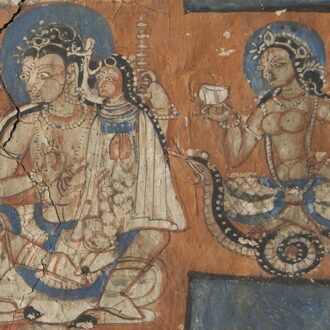Thesis: Early Period Buddhist Wall Paintings Of Ladakh From The 11th To Early 13th Century: Materials, Techniques & Conservation Implications
Supervised by Professor Aviva Burnstock and Emily Howe
Funded by AkzoNobel Scholarship
Ladakh, in the Western Himalayas, has been and remains a significant centre of Tibetan Buddhism. This region of India is marked by numerous Buddhist monasteries, temples and chortens, many of which are adorned with stunning wall paintings. The development of Tibetan Buddhism in the region is ascribed to the tenth to twelfth century CE following the ‘second propagation’ of Buddhism in Tibet. Manuscripts, sculptures and wall paintings flourished under the patronage of western Tibetan kingdom and that of Lotsawa Rinchen Zangpo (958-1056), the ‘Great Translator’ of Sanskrit Buddhist texts. Rinchen Zangpo inspired the foundation of several temples and monasteries across Ladakh during his lifetime and is also credited for bringing in artists from neighbouring Kashmir, thus infusing a new artistic tradition inspired by contemporaneous Kashmiri art, a characteristic of the ‘early period’ temples through the eleventh to early thirteenth century.
Recent publications on early period Buddhist wall paintings in Ladakh focus mainly on iconography, style and other art historical matters, but painting materials and technologies remain virtually unstudied. Many wall painting conservation projects are currently ongoing in Ladakh. Knowledge of original materials is one of the cornerstones of conservation and while great efforts have been made to allocate resources to such investigations the paucity of technical data on early Buddhist wall paintings in Ladakh is largely unaddressed. Such lack of knowledge seriously hampers the understanding of deterioration mechanisms and the assessment of the suitability of conservation approaches and materials.
It is hence proposed to carry out a systematic study of ‘early period’ wall paintings executed between eleventh and early thirteenth century in the Ladakh region. The aim is to identify their materials and technology from their support to earthen-based plaster layers, to paint layers and final glazes, and to shed light on similarities, developments and differences throughout the period studied. The proposed research seeks to apply scientific methods to contribute to a better understanding of the technique and variation in technique of wall paintings and to begin to better understand their inherent susceptibility to deterioration and implications in terms of conservation issues and approaches.
Major sites in Ladakh being focused in the current research include temples at Nyarma (near Thikse), Zangla (Malakartse Chorten), Tragkhung Kowache, Mangyu, Sumda Chun, Sumda Chenmo, Skiu and Alchi. Extensive studies are being carried out on all these sites, some of which are difficult to access and not well known. Investigations at some sites led to the discovery of paint layers that were concealed and never documented. Sophisticated instrumental analysis carried out on selected samples revealed valuable information that will add on to the history of painting in the region.
Education
- M.A. Conservation & Restoration of Works of Art (2001) – National Museum Institute, New Delhi
- B.Sc Physics (1995) – University of Calicut, Kerala
Research interests
- Painting technique
- Buddhist Art
- Wall painting conservation
- Conservation Science
Publications
- Pinto, M.; M.S. Gill; M. Georgakopoulou; and Menon, S. (2018). ‘Examination of 14–15th century Buddhist wall paintings from a cave complex in Saspol, Ladakh’, Journal of Archaeological Science: Reports, 21, pp. 259–267. doi: 10.1016/j.jasrep.2018.07.016.
- Gill, M. S.; Menon, S; Mohanty, P. P. (2016). ‘Conservation of wall paintings of Karugma Lakhang, Igu, Ladakh‘ Conservation of Cultural Property in India, Vol. 41, 62-71, Indian Association for the Study of Conservation of Cultural Property, New Delhi.
- Gill, M. S., Priego Rendo, C. and Menon, S. (2014) ‘Materials and techniques; Early Buddhist wall paintings and sculptures at Sumda Chun, Ladakh.’, Studies in conservation. Maney Publishing, 59(5), pp. 300–313.
- Fonjaudran, C. M, Menon, S., & Gill, M. S. (2013), Sumda Chun and other early Buddhist wall painting in Ladakh: Practical and ethical conservation issues from failing structures to obscuring surface layers. In D. Park, K. Wangmo, & S. Cather (Eds.), Art of Merit: Studies in Buddhist Art and its Conservation. London,203-218, Archetype Publications.
- Fonjaudran, C. M., Tringham, S., Bogin, S., Menon, S., and Jasol, K.S. (2011), ‘Cultural identity, conservation approaches and dissemination: Conserving the wall paintings of Nagaur Fort, Rajasthan, India‘ ICOM-CC, Lisbon.Publications.
- Menon, S. and Gill, M.S. (2011), ‘Conservation of oil paintings of Raja Ravi Varma‘, Conservation of Cultural Property in India, Vol. 39, 26-32, Indian Association for the Study of Conservation of Cultural Property, New Delhi.
- Menon, S., Gill, M. S. Verhave, J and Blok, V. (2008), ‘Conservation of Khatamband Polychrome Decorative Ceilings‘, Fifteenth Triennial Conference, New Delhi, 22-26 September 2001, ICOM-CC, NewDelhi.
- Gill, M.S and Menon, S. (2008), ‘Condition mapping and assessment of decorative features on monuments‘, Asian Regional Cooperation Conference, 9-17, INTACH, New Delhi
